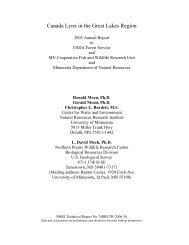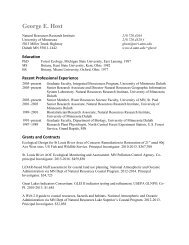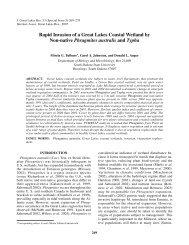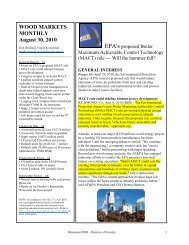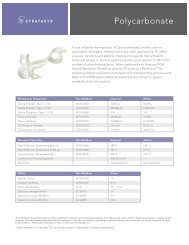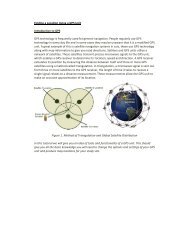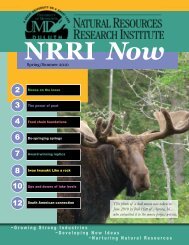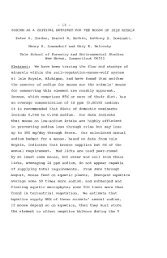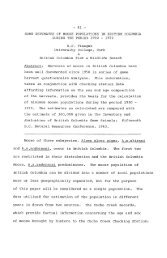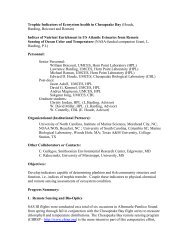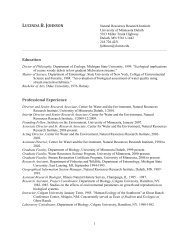Download the dichotomous key
Download the dichotomous key
Download the dichotomous key
You also want an ePaper? Increase the reach of your titles
YUMPU automatically turns print PDFs into web optimized ePapers that Google loves.
Great Lakes Worm Watch<br />
Key to exotic earthworm species common in <strong>the</strong> Great Lakes region<br />
This <strong>dichotomous</strong> <strong>key</strong> will lead you step by step to <strong>the</strong> identification of your earthworm. Begin at<br />
To identify an earthworm to species you generally need and adult specimen (with a clitellum) and<br />
1<br />
The earthworm is a juvenile (lacks a clitellum)<br />
GO TO 2<br />
The earthworm is an adult (has a clitellum)<br />
GO TO 7<br />
The earthworm is pigmented<br />
GO TO 3<br />
2<br />
The earthworm is non-pigmented<br />
GO TO 6<br />
The earthworm has paired setae<br />
GO TO 4<br />
The earthworm has separate setae<br />
3<br />
Dendrobaena octaedra<br />
The earthworms setae are a row of bristles around each<br />
Amynthus species<br />
The earthworm has widely paired setae<br />
Dendrodrilus rubidus<br />
4<br />
The earthworm has closely paired setae<br />
GO TO 5<br />
The fresh specimen has distinctive yellow banding in <strong>the</strong> intersegmental<br />
grooves<br />
Eisenia fetida<br />
There is no yellow coloring in <strong>the</strong> intersegmental groves on fresh<br />
specimens<br />
5<br />
Lumbricus rubellus or Lumbricus terrestris or Eisenia eiseni or<br />
Eiseniella tetraedra or Aporrectodea longa (Note: it is impossible<br />
to distinguish <strong>the</strong>se species when <strong>the</strong>y are juveniles. Depending on<br />
which of <strong>the</strong>se species you have found as adults, you may be able to<br />
make reasonable conclusions about <strong>the</strong> identity of <strong>the</strong> juveniles.)<br />
The earthworm has closely paired setae<br />
Aporrectodea species or Allolobophora chlorotica (Note: if <strong>the</strong> fresh<br />
specimen has a distinctive greenish color, you could conclude that it is<br />
Allolobophora chlorotica)<br />
6 The earthworm has widely paired setae<br />
Octolasion tyrtaeum or Octolasion cyaneum<br />
The earthworms setae are a row of bristles around each<br />
segment<br />
Amynthus species<br />
The earthworm is pigmented<br />
GO TO 8<br />
7<br />
The earthworm is non-pigmented<br />
GO TO 15<br />
The earthworm has paired setae<br />
GO TO 9<br />
The earthworm has separate setae<br />
8 Dendrobaena octaedra<br />
The earthworms setae are a row of bristles around each<br />
segment<br />
Amynthus species<br />
The earthworm has widely paired setae<br />
Dendrodrilus rubidus<br />
9<br />
The earthworm has closely paired setae<br />
GO TO 10
10<br />
The clitellum start before segment 25<br />
GO TO 11<br />
The clitellum start after segment 25<br />
GO TO 12<br />
Male pore is on segment 13<br />
Eiseniella tetraedra (Note: For this species, <strong>the</strong> clitellum starts<br />
on segment 23 (or 22) and extends to segment 26 (or 27). It also<br />
11 has a broad TP)<br />
Male pore not on segment 13<br />
Eisenia eiseni (Note: For this species, <strong>the</strong> clitellum starts on<br />
segment 24 (or 23) and extends to segment 32. It has no TP)<br />
15<br />
The clitellum starts on segment 32, or definitely after segment 30<br />
12 Lumbricus terrestris<br />
The clitellum starts before segment 30<br />
GO TO 13<br />
The clitellum starts on segments 26 or 27 and obvious yellow color<br />
in <strong>the</strong> intersegmental grooves is not present.<br />
GO TO 14<br />
13<br />
The clitellum starts on segments 24, 25 or 26 and obvious yellow<br />
color in <strong>the</strong> intersegmental grooves is present.<br />
Eisenia fetida<br />
The clitellum is on segments 27 (or 26) through 32 and if GT are<br />
present, <strong>the</strong>y are not limited to segments 31,33 and 34.<br />
Lumbricus rubellus<br />
14 The clitellum is on segments 27 through 34 and if GT are present,<br />
<strong>the</strong>y limited to segments 31,33 and 34. Earthworms is lightlybrown<br />
pigmented on head, between 15cm in length<br />
Aporrectodea longa<br />
The earthworm has widely paired setae<br />
GO TO 16<br />
The earthworm has closely paired setae<br />
GO TO 17<br />
The clitellum is on segments 30-35 (may be orangish in color) with long<br />
narrow (linear) TP on segments 31-34<br />
Octolasion tyrtaeum<br />
The clitellum is on segments 29-34 (usually beige or yellowish in color) with<br />
wide TP on segments 30-33 that have a puckered appearance on <strong>the</strong> ventral<br />
16<br />
(belly) edge<br />
Octolasion cyaneum<br />
The earthworms setae are a row of bristles around each<br />
segment<br />
Amynthus species<br />
The clitellum starts on segments 27 or later<br />
GO TO 18<br />
The clitellum is on segments 25-32 and maybe noticeable flared. The TP, if<br />
17 present is small and continuous on segments 29-31. Earthworm is
The TP is distinctly notched or, when not fully developed, may appear as two<br />
triangles or circular bumps side by side<br />
GO TO 20 (Note: if identification cannot proceed beyond this step, <strong>the</strong><br />
19<br />
earthworm should be identified as Aporrectodea caliginosa complex)<br />
The TP is linear or oval, but not notched<br />
GO TO 21<br />
The GT are on alternating segments in clitellum (30,32,34)<br />
Aporrectodea tuberculata<br />
20 The GT are on both alternative and consecutive segments in clitellum (27,30,<br />
32-34)<br />
Aporrectodea caliginosa<br />
The GT are on alternative and consecutive segments (28,30,32-34) and<br />
earthworm has no pigmentation<br />
Aporrectodea trapezoides<br />
21<br />
The GT are on consecutive on segments (31, 33, 34) and earthworm has light<br />
brown pigmentation on <strong>the</strong> head<br />
Aporrectodea longa



